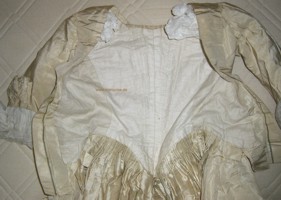| INDEX | 1300-1599 | 1600s | 1700s | 1800s | 1900s | CROSS-ERA | ETHNO | |
| MISCELLANY | CONTACT | SEARCH | |
 This
how-to expects you to drape the pattern yourself, so the most important implement
is a dummy that reflects your corseted body shape. (Assuming, for simplicity,
that you are sewing for yourself.) Preferably a dummy that you can stick pins
into. You can find instructios for making one by googling "duct tape dummy".
I myself believe strongly in dummies made from polyurethane foam, but I'm afraid
I haven't translated the instrucions
yet.
This
how-to expects you to drape the pattern yourself, so the most important implement
is a dummy that reflects your corseted body shape. (Assuming, for simplicity,
that you are sewing for yourself.) Preferably a dummy that you can stick pins
into. You can find instructios for making one by googling "duct tape dummy".
I myself believe strongly in dummies made from polyurethane foam, but I'm afraid
I haven't translated the instrucions
yet.
There is an extra how-to on draping the lining, but again... maybe the pictures will help... sorry.
As for choosing a top fabric, what I wrote on the Sack-back gown pages applies. Also see Fabrics of the 18th century.
I haven't calculated the fabric consumption yet. As a rough estimate I'd say, for 150 cm wide fabric, once the measurement from shoulder to ground plus 10 cm, once the skirt length plus 10, plus 60 cm. Any decorations should come out of the rest, unless you want to add ruffles and the like all over. For the petticoat, twice the maximum skirt length.
The lining of the bodice requires 50-75 cm @150 width of a firm linen-weave fabric which doesn't distort easily. For maximum authenticity, use a fine, very densely woven Linen. A good alternative is old bed linen fabric which tends to have the right dregree of fineness and density. On the other hand, it's usually cotton, and that's authenticity down the drain if you're portraying England pre-1774. For Noth America and Netherlands it's OK.
The skirt part of my model was also lined. This is not really necessary, and seeing that the lining is pretty thin and flimsy, I don't really understand why the seamstress bothered. If you want to reproduce it anyway, choose a super-thin, largely translucent linen weave silk, the kind that silk painters use. The thinnest, lightest one.
For the skirt waistband, 2-4 m linen tape, 2-3 cm wide. Silk sewing thread in the colour of the top fabric. Linen thread for the lining.
Optional: Two lead discs with a diameter of 4 cm, 3mm thick. They were sewn into the sleeves of the model, probably to improve the hang.
Next step: The pattern
Content, layout and images of this page
and any sub-page of the domains marquise.de, contouche.de, lumieres.de, manteau.de and costumebase.org are copyright (c) 1997-2022 by Alexa Bender. All rights reserved. See Copyright Page. GDPO
This work is licensed under a Creative Commons License.